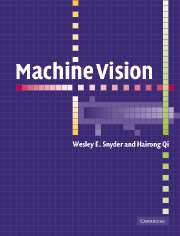Book contents
- Frontmatter
- Contents
- To the instructor
- Acknowledgements
- 1 Introduction
- 2 Review of mathematical principles
- 3 Writing programs to process images
- 4 Images: Formation and representation
- 5 Linear operators and kernels
- 6 Image relaxation: Restoration and feature extraction
- 7 Mathematical morphology
- 8 Segmentation
- 9 Shape
- 10 Consistent labeling
- 11 Parametric transforms
- 12 Graphs and graph-theoretic concepts
- 13 Image matching
- 14 Statistical pattern recognition
- 15 Clustering
- 16 Syntactic pattern recognition
- 17 Applications
- 18 Automatic target recognition
- Author index
- Index
14 - Statistical pattern recognition
Published online by Cambridge University Press: 05 June 2012
- Frontmatter
- Contents
- To the instructor
- Acknowledgements
- 1 Introduction
- 2 Review of mathematical principles
- 3 Writing programs to process images
- 4 Images: Formation and representation
- 5 Linear operators and kernels
- 6 Image relaxation: Restoration and feature extraction
- 7 Mathematical morphology
- 8 Segmentation
- 9 Shape
- 10 Consistent labeling
- 11 Parametric transforms
- 12 Graphs and graph-theoretic concepts
- 13 Image matching
- 14 Statistical pattern recognition
- 15 Clustering
- 16 Syntactic pattern recognition
- 17 Applications
- 18 Automatic target recognition
- Author index
- Index
Summary
Statistics are used much like a drunk uses a lamppost: for support, not illumination
Vin ScullyThe discipline of statistical pattern recognition by itself can fill textbooks (and in fact, it does). For that reason, no effort is made to cover the topic in detail in this single chapter. However, the student in machine vision needs to know at least something about statistical pattern recognition in order to read the literature and to properly put the other machine vision topics in context. For that reason, a brief overview of the field of statistical methods is included here. To do serious research in machine vision, however, this chapter is not sufficient, and the student must take a full course in statistical pattern recognition. For texts, we recommend several: The original version of the text by Duda and Hart [14.3] included both statistical pattern classification and machine vision, however, the new version [14.4] is pretty much limited to classification, and we recommend it for completeness. The much older text by Fukanaga [14.6] still retains a lot of useful information, and we recommend [14.11] for readability.
Design of a classifier
Recall the example described in section 13.2. In that example, we are given models for axes and hatchets which were derived statistically by computing averages of samples known to be either axes or hatchets. We called these collections “training sets.”
- Type
- Chapter
- Information
- Machine Vision , pp. 326 - 355Publisher: Cambridge University PressPrint publication year: 2004



